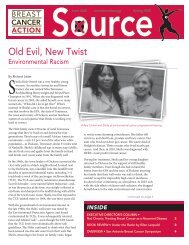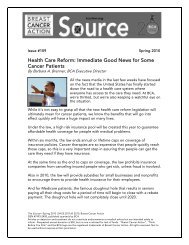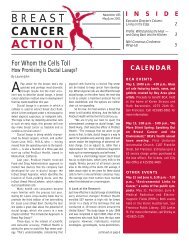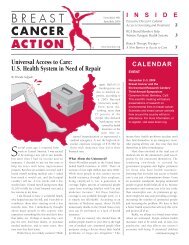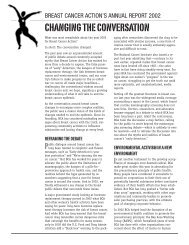Download Newsletter #61 in PDF Format - Return to Home Page ...
Download Newsletter #61 in PDF Format - Return to Home Page ...
Download Newsletter #61 in PDF Format - Return to Home Page ...
Create successful ePaper yourself
Turn your PDF publications into a flip-book with our unique Google optimized e-Paper software.
6<br />
September/Oc<strong>to</strong>ber 2000<br />
Breast Cancer Action<br />
Sal<strong>in</strong>e Implants: For<br />
Better or for Worse<br />
By Lauren John<br />
Ilan Reich does not know how many<br />
women use his company’s sal<strong>in</strong>e-filled<br />
breast implants for breast reconstruction<br />
after cancer surgery. But they must benefit<br />
from the implants, he says, because —<br />
despite complications rang<strong>in</strong>g from <strong>in</strong>fection<br />
<strong>to</strong> deflation <strong>to</strong> harden<strong>in</strong>g — women keep<br />
buy<strong>in</strong>g them. What greater proof of cus<strong>to</strong>mer<br />
satisfaction could there be, Reich<br />
asks, than the fact that so many women<br />
opt <strong>to</strong> replace their sal<strong>in</strong>e implants rather<br />
than forgo them entirely — even if the<br />
product has failed<br />
Reich is the president of Inamed Inc.,<br />
which is the parent company of the<br />
McGhan Medical Corporation, a Santa<br />
Barbara, California–based sal<strong>in</strong>e implant<br />
manufacturer. McGhan Medical is one of<br />
two companies that received Food and<br />
Drug Adm<strong>in</strong>istration approval for its<br />
sal<strong>in</strong>e implants this May. (The second<br />
manufacturer, also based <strong>in</strong> Santa Barbara,<br />
is the Men<strong>to</strong>r Corporation.)<br />
The American Society of Plastic and<br />
Reconstructive Surgery reports that close<br />
<strong>to</strong> 70,000 women had breast reconstruction<br />
follow<strong>in</strong>g mastec<strong>to</strong>my <strong>in</strong> 1998, up<br />
from about 30,000 reconstruction procedures<br />
done <strong>in</strong> 1992. About a fifth of this<br />
group — close <strong>to</strong> 14,000 women — chose<br />
<strong>to</strong> have sal<strong>in</strong>e implants.<br />
Imag<strong>in</strong>is.net, an Internet health <strong>in</strong>formation<br />
site, offers similar statistics: Accord<strong>in</strong>g <strong>to</strong><br />
the site, approximately 15,000 breast cancer<br />
patients elected <strong>to</strong> have sal<strong>in</strong>e breast implants<br />
after mastec<strong>to</strong>my <strong>in</strong> 1999. Meanwhile, the<br />
site reports, about 135,000 women received<br />
sal<strong>in</strong>e implants for cosmetic reasons.<br />
Over the past five years, McGhan<br />
Medical has run three cl<strong>in</strong>ical trials <strong>to</strong> determ<strong>in</strong>e<br />
the short-term and most common risks<br />
associated with sal<strong>in</strong>e implants. Of the<br />
4,013 women enrolled <strong>in</strong> the studies, 462<br />
were given the implants after reconstruction.<br />
About half of the reconstruction patients, or<br />
225 women, were enrolled <strong>in</strong> a one-year<br />
trial (and only about two-thirds returned for<br />
their one-year follow-up visit). The rest of<br />
the reconstruction patients under study —<br />
237 women — were enrolled <strong>in</strong> a five-year<br />
study, with 76 percent return<strong>in</strong>g for their<br />
three-year follow-up visit. (The third study<br />
exam<strong>in</strong>ed only women who had undergone<br />
a u g m e n t a t i o n . )<br />
Could these studies provide enough<br />
<strong>in</strong>formation <strong>to</strong> determ<strong>in</strong>e whether the<br />
implants were safe for women who have had<br />
breast reconstruction And was three years<br />
long enough <strong>to</strong> get answers<br />
“The FDA thought it was,” Reich<br />
responds confidently.<br />
Hazardous <strong>to</strong> Your Health<br />
In May the FDA approved the implants<br />
manufactured by the two Santa Barbara–<br />
based companies even though it publicly<br />
acknowledged that the devices have “relatively<br />
high complication and failure rates,”<br />
particularly for breast cancer patients. 1<br />
A ruptured sal<strong>in</strong>e implant, pho<strong>to</strong>graphed by<br />
breast cancer activist Anne Stansell<br />
“Women should understand that breast<br />
implants do not last a lifetime,” David Feigal,<br />
head of the FDA’s Center for Devices and<br />
Radiological Health, said <strong>in</strong> a public statement<br />
after their approval was announced. “It<br />
is clear that there is a possibility that a substantial<br />
number of women who get these<br />
implants will require additional surgery<br />
at some po<strong>in</strong>t <strong>to</strong> remove or replace<br />
their implants because of complications,”<br />
he cont<strong>in</strong>ued. 2<br />
Us<strong>in</strong>g data from several Men<strong>to</strong>r and<br />
McGhan Medical studies, the FDA concluded<br />
that 13 <strong>to</strong> 21 percent of cosmetic-surgery<br />
patients and 40 percent of breast cancer<br />
patients were likely <strong>to</strong> need repeat surgeries<br />
with<strong>in</strong> one <strong>to</strong> three years of receiv<strong>in</strong>g sal<strong>in</strong>e<br />
implants. In some cases, an old implant is<br />
replaced with a new one after the orig<strong>in</strong>al<br />
deflates. In other <strong>in</strong>stances, when scar tissue<br />
or sk<strong>in</strong> that normally forms around an<br />
implant tightens and squeezes the implant (a<br />
process plastic surgeons refer <strong>to</strong> as c a p s u l a r<br />
c o n t r a c t u r e), surgery would be needed <strong>to</strong><br />
remove scar tissue. In fact, several studies<br />
show that women who receive implants for<br />
breast reconstruction after mastec<strong>to</strong>my are<br />
twice as likely <strong>to</strong> suffer complications than<br />
women who undergo augmentation.<br />
Sal<strong>in</strong>e breast implants can also cause<br />
dimpl<strong>in</strong>g and pucker<strong>in</strong>g at the implant site,<br />
loss of nipple sensation (which is usually preserved<br />
for women who have undergone augmentation),<br />
and asymmetry.<br />
In a three-year study of 416 women who<br />
received Men<strong>to</strong>r implants for breast reconstruction,<br />
40 percent needed additional<br />
surgery and 27 percent asked that the<br />
implants be removed, usually because of<br />
complications such as <strong>in</strong>fections, pa<strong>in</strong>,<br />
harden<strong>in</strong>g, or deflation. (In some cases,<br />
the implants had <strong>to</strong> be removed because<br />
they had ruptured and leaked. In fact, one<br />
study showed that about 9 percent of<br />
Men<strong>to</strong>r implants given <strong>to</strong> breast cancer<br />
patients ruptured and deflated with<strong>in</strong><br />
three years.)<br />
Doc<strong>to</strong>rs Warned — Not Patients<br />
The FDA approved the sal<strong>in</strong>e implants<br />
with the stipulation that women be warned<br />
of their risks. The warn<strong>in</strong>gs are slated <strong>to</strong><br />
come <strong>in</strong> the form of <strong>in</strong>serts or educational<br />
materials that will be <strong>in</strong>cluded <strong>in</strong> or on the<br />
implants’ boxes — mean<strong>in</strong>g that patients<br />
are left out of the direct flow of <strong>in</strong>formation.<br />
In many cases, then, it will be up <strong>to</strong><br />
doc<strong>to</strong>rs <strong>to</strong> <strong>in</strong>form patients of the risks.<br />
Some patients, of course, will take <strong>to</strong><br />
the Internet for consumer <strong>in</strong>formation,<br />
and the FDA has posted the warn<strong>in</strong>gs at<br />
its site (www.fda.gov). And McGhan Medical<br />
has posted the same warn<strong>in</strong>gs prom<strong>in</strong>ently<br />
on its Web site (www.mcghan.com), <strong>in</strong> an<br />
article entitled “Sal<strong>in</strong>e-Filled Breast Implant<br />
Surgery: Mak<strong>in</strong>g an Informed Decision.” As of<br />
press time, the Men<strong>to</strong>r Corporation had yet<br />
<strong>to</strong> post any warn<strong>in</strong>gs at its site (www.men<strong>to</strong>rc<br />
o r p . c o m ) .Diane Hart, patient services manager<br />
at Men<strong>to</strong>r, says that the company is <strong>in</strong><br />
the process of revis<strong>in</strong>g its educational materials<br />
<strong>to</strong> reflect the new FDA guidel<strong>in</strong>es. Once<br />
they are updated, <strong>in</strong>formation packets will be<br />
sent directly <strong>to</strong> patients who request them<br />
(call 805/879-6000).<br />
In the past, Men<strong>to</strong>r has made a video<br />
titled “Options <strong>in</strong> Reconstruction” available <strong>to</strong><br />
doc<strong>to</strong>rs and women’s health centers (<strong>in</strong>clud<strong>in</strong>g<br />
the Community Breast Health Project <strong>in</strong> Palo<br />
Al<strong>to</strong>, California, whose cofounder, breast surgeon<br />
Ellen Mahoney, praises it as “one of the<br />
most honest videos I have seen.”) When I<br />
asked Hart whether I could obta<strong>in</strong> a copy, she<br />
<strong>to</strong>ld me that Men<strong>to</strong>r was consider<strong>in</strong>g whether<br />
<strong>to</strong> update the video, add<strong>in</strong>g that it is not a high<br />
priority right now. If the company decides <strong>to</strong><br />
update it, copies will be sent <strong>to</strong> breast cancer



